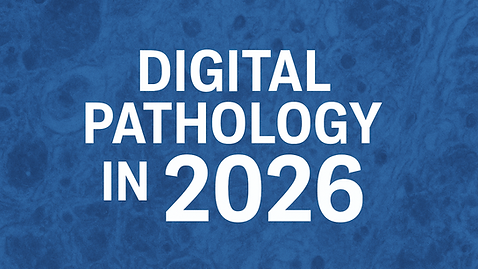
A Message to Commission on Cancer Hospitals and Cancer Centers
Ken Dec, Chief Marketing Officer, mTuitive
As we look toward 2026, digital pathology stands at a transformative inflection point. For Commission on Cancer (CoC)-accredited hospitals and cancer centers, the coming year represents more than just technological evolution—it marks the moment when structured pathology data becomes central to cancer care delivery, quality reporting, and patient outcomes.
The Structured Data Imperative
The shift from narrative pathology reports to structured, standardized data continues to accelerate. In 2026, we anticipate this transition will reach critical mass, driven by several converging forces:
Regulatory and Accreditation Pressures: CoC standards increasingly emphasize complete, accurate, and timely data capture for cancer registry reporting. As synoptic reporting becomes the expectation rather than the exception, pathology departments face mounting pressure to deliver structured data that seamlessly populates tumor registries without manual abstraction.
CAP eCC Protocol Adoption: The College of American Pathologists' electronic Cancer Checklists (eCC) protocols have evolved from optional best practices to essential infrastructure. In 2026, we expect to see near-universal adoption among cancer centers, with structured templates embedded directly into digital pathology workflows.
Interoperability Requirements: Federal initiatives around healthcare data exchange mean pathology data can no longer exist in silos. Structured pathology reports must flow seamlessly into EHRs, tumor registries, and clinical decision support systems.
What This Means for Your Institution
For CoC-accredited facilities, 2026 will bring both challenges and opportunities:
Enhanced Quality Metrics and Benchmarking
Structured pathology data enables real-time quality monitoring and benchmarking against national standards. Institutions will increasingly leverage this data to:
Track adherence to CAP protocol completion rates
Monitor turnaround times for critical diagnoses
Identify variations in diagnostic practices
Demonstrate compliance with CoC standards more efficiently
Streamlined Registry Operations
The manual abstraction bottleneck that has long plagued cancer registries will continue to diminish. With properly structured pathology data, registrars can spend less time on data extraction and more time on quality assurance, outcomes analysis, and clinical research support.
AI-Augmented Pathology Workflows
Artificial intelligence tools trained on structured data will become more sophisticated and clinically useful in 2026. Expect to see:
Automated quality checks that flag incomplete or inconsistent data elements
Predictive analytics that identify patients who may benefit from molecular testing
Decision support tools that suggest appropriate staging and classification based on structured findings
The mTuitive Perspective: Making Structure Seamless
At mTuitive, we recognize that the promise of structured data only materializes when the technology supports, rather than burdens, pathologists in their daily work. As we look to 2026, our focus remains on:
Intelligent Template Design: Creating structured reporting interfaces that feel natural to pathologists, reducing cognitive load while ensuring comprehensive data capture.
Workflow Integration: Embedding structured data capture at the point of diagnosis, not as an afterthought, so pathologists can focus on interpretation rather than data entry.
Bidirectional Communication: Ensuring structured data flows both into registries and back to clinicians in formats that support decision-making at the point of care.
Future-Ready Infrastructure: Building systems that can adapt to evolving CAP protocols, emerging biomarkers, and new regulatory requirements without requiring wholesale system replacements.
Preparing for 2026: Strategic Considerations
For cancer program administrators and pathology leaders, now is the time to assess your institution's readiness:
Audit Your Current State: What percentage of your cancer cases currently use structured, synoptic reporting? Where are the gaps?
Evaluate Your Technology Stack: Does your digital pathology platform truly support structured data, or does it simply digitize traditional reporting?
Engage Your Stakeholders: Pathologists, registrars, oncologists, and IT teams must align on structured data goals and workflows.
Plan for Training and Change Management: Technology is only as effective as its users. Invest in education and ongoing support.
Consider Your Data Strategy: How will you leverage structured pathology data for quality improvement, research, and clinical care beyond basic compliance?
The Opportunity Ahead
While the push toward structured data may feel like another regulatory requirement, it represents something far more significant: an opportunity to fundamentally improve cancer care. When pathology data is structured, standardized, and accessible, it becomes a strategic asset that drives better decisions, better outcomes, and better patient experiences.
In 2026, the gap between leaders and laggards in digital pathology will widen. Institutions that embrace structured data as a strategic priority, not just a compliance checkbox, will find themselves better positioned to deliver high-quality cancer care, attract top talent, pursue cutting-edge research, and maintain their CoC accreditation with confidence.
The future of pathology is structured, integrated, and intelligent. At mTuitive, we're committed to making that future accessible to every cancer program we serve.
mTuitive is revolutionizing reporting, data, and analytical software for digital pathology and surgical oncology. Their innovative synoptic reporting software allows for the aggregation of a patient's data with thousands of different reports, giving medical professionals new insights and understanding to elevate the standard of care and benefit the patient. By capturing all required data and ensuring standards compliance, hospitals and surgery centers can improve efficiency and accuracy. With a commitment to continued innovation, mTuitive is at the forefront of shaping the future of medicine, enabling the best minds in healthcare to make better decisions and provide the best possible outcomes for patients. Learn more at www.mtuitive.com.

